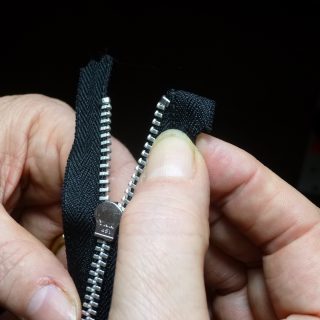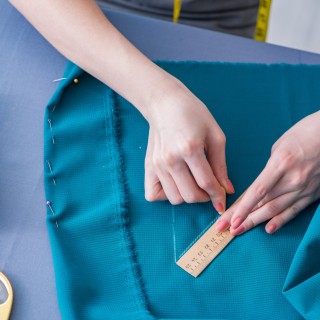Everything needs to be tidied up once in a while, and a sewing machine is no exception.
After turning tons of regular pieces of cloth into artwork, your sewing machine collects lint and dust in hard-to-see places, and, if not cleaned regularly, it may lead to poor performance, or worst-case scenario, damage to your machine.
Follow my handy steps below to clean your sewing machine safely, keeping it in good shape for years to come.
Before You Clean
One of the most important things before beginning the process of tidying up your sewing machine is to prepare yourself by gathering the right equipment. Here are all the bits and pieces you’ll need to successfully complete the process:
- See whether the machine comes with a specific, tiny brush, if not, find a stiff paint or toothbrush.
- Both a muslin and a soft cloth
- Screwdriver
- A compact, handheld vacuum cleaner
- Sewing machine oil
- Tweezers
- Manual
- Dental floss & picks
- Nail polish remover or orange cleaner
Before diving into the whole process, I’d like to point out that the cleaning of your sewing machine depends on the frequency of use and the fabrics you use during the production. If sewing is more of a hobby than a profession to you, then you can clean once every three to four months. If, on the other hand, you sew regularly, using fabrics that shed easily – you might want to tidy it up once a week or every time you notice a build-up.
The Cleaning Process
Step One: Unplug the Sewing Machine
Unplugging the sewing machine is perhaps the most significant step towards successful cleaning to avoid undesirable injuries. This will protect you from needing stitches if you accidentally step on your pedal while cleaning.
Step Two: Wipe Down the Exterior Surfaces
The best way to clean the sewing machine’s exterior surfaces from dust and lint is by using a soft cloth. Clean from top to bottom to allow dust and dirt to collect on the floor. Although some surfaces require cleaning with a wet cloth to remove grime, as gear and metal are susceptible to dust, make sure not to moisten the moving parts.
Step Three: Clean Under the Throat Plates and Feed Dogs
Under the throat plate is where you may find crumpled-up threads, dust, and lint, which requires you to pay special attention while cleaning. To access under the throat plate, carefully unscrew the throat plate using a screwdriver while making sure to store the screws in a safe and secure place so you won’t lose them.
Once you have disassembled the throat plate, use your tiny brush and the tweezers to get rid of stray thread and lint from the entire area, including the feed dogs. For a better visibility, you can either lower or raise the feed dogs.
Use a handy vacuum cleaner to suck up dust and lint from places your brush can’t reach.
Step Four: Clean the Bobbin Case & Shuttle Hook
When it comes to making a perfect stitch, nothing is more important than keeping the bobbin case clean.
Once your bobbin compartment is opened up, which is under the throat plate, remove the bobbin and with it the bobbin case to sweep the build-up of dust and lint. The way you approach this depends on whether your machine uses a front-loading or a top-loading bobbin.
While reaching the bobbin case in front-loading sewing machines requires as simple an action as swinging a trap door open, the top-loading machines are a bit more complicated – requiring you to use a screwdriver to dismantle the throat plate.
The moment you open the bobbin compartment in a top-loading sewing machine, you can take the bobbin to wipe out dust and lint with your brush thoroughly.
The moment the front-loading machine’s throat plate pops open, make sure to remove and clean the bobbin case as thoroughly as you can. Make sure to give it a good brush around to eliminate lint build-up or other fluffy bits first, and then use a soft cloth to wipe down the remaining dust particles.
Step Five: Clean the Needles
When it comes to cleaning a sewing machine needle, there are a lot of solutions that can seamlessly do the trick. As basic essentials that almost everybody has in their homes, nail polish removers or orange cleaners are the ones that I personally recommend.
Spray the needle with the solution of your choice, gently rubbing it with a dry towel to remove every particle. Use dental picks to target smaller areas, removing even the tiniest dust particles.
Step Six: Thoroughly Clean the Tension Discs
Dust and lint can significantly lower tension discs’ productivity, not allowing them to properly control the amount of pressure applied to the thread. Whether your machine uses internal discs or these are easily reachable from the outside, make sure to discover their location by referencing the manual.
Once you discover their location, raise the feed dogs and unleash the tension discs or pressure controllers. The next step requires you to remove all the particles between these pressure controllers by flossing or vacuuming. One way to complete this goal is by using a piece of fleece that’s around ten inches long, rubbing it around the tension discs until all the particles are removed.
Step Seven: Oil the Machine
After thoroughly cleaning your sewing machine, make sure to go through your manual and study the brand’s recommendations about oiling. As every machine provides a different manual, remember to pay special attention to the amount of oil required as well as the exact areas where you need to insert the oil drops.
Step Eight: Reassemble Your Machine
Depending on whether or not the steps to assemble your sewing machine are complicated or not, you may need to use your manual once again. Use the screwdriver once again to tighten all the screws properly.
Step Nine: Clean the Foot Pedal
Tidying up the foot pedal is an often overlooked yet quite important part of the cleaning process.
The best part about cleaning the foot pedal is that there aren’t intricate parts inside, making the entire process easier. As some of the inside parts are susceptible to breaking, be as mindful as you can to prevent any accidents from happening. To begin, make sure the machine is unplugged, remove the back cover and fully open the foot pedal.
Use a compact vacuum cleaner to vacuum all the dust particles, and once you are finished, reach to all places available with a soft cloth and gently remove the remaining dirt. Before you put the cover back, insert a few oil drops on the moving parts, and you’re all set.
Step Ten: Prepare the Sewing Machine for Your Next Project
To protect your next project from coming into contact with oil, go through the surface of your machine with a muslin piece of fabric to absorb everything that is left.
The next step requires you to plug your machine back in and run it with a piece of scrap fabric to work in the remaining oil.
Here’s my last tip: If you are not planning to use the machine once you’re finished with the entire process, cover it to prevent dust build-up.
There – you are ready for your next project! Might I suggest creating a double-sided blanket, a
throw blanket, or fixing your pair of ripped jeans.
Keep Your Sewing Machine Maintained
Most manufacturers advise that you take your sewing machine to a licensed dealer for occasional maintenance. A licensed dealer will not only clean the machine thoroughly but will also adjust your tension while executing repair work on its moving parts.
Final Takeaway
Now that you know all these steps make sure you regularly clean your sewing machine to avoid uneven stitches, skipped stitches, or broken threads right in the middle of a seam – making your sewing experience a nuisance.





